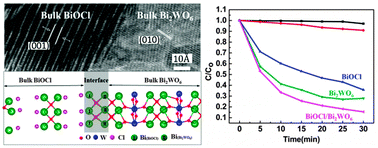Enhanced photosensitized activity of a BiOCl–Bi2WO6 heterojunction by effective interfacial charge transfer†
Abstract
A BiOCl–Bi2WO6 heterojunction with a chemically bonded interface was synthesized via a facile one-step solvothermal method. A series of characterization techniques (XRD, XPS, TEM, SEM, EDS etc.) confirmed the existence of a BiOCl–Bi2WO6 interface. The heterojunction yielded a higher photodegradation rate of Rhodamine B under visible light irradiation compared to its individual components. Theoretical studies based on density functional theory calculations indicated that the enhanced photosensitized degradation activity could be attributed to the favorable band offsets across the BiI–O–BiII bonded interface, leading to efficient interfacial charge carrier transfer. Our results reveal the photosensitized mechanism of BiOCl–Bi2WO6 heterojunctions and demonstrate their practical use as visible-light-driven photocatalytic materials.


 Please wait while we load your content...
Please wait while we load your content...